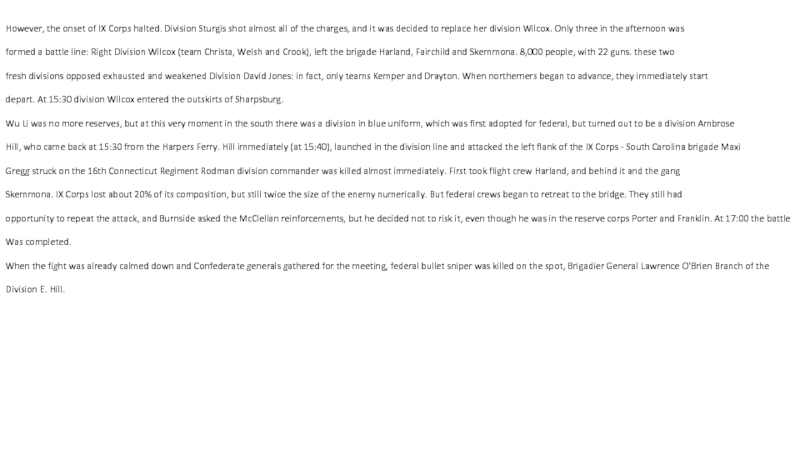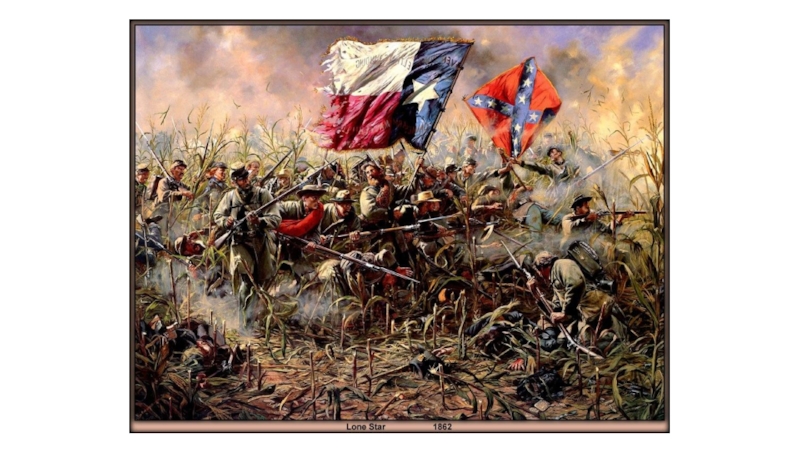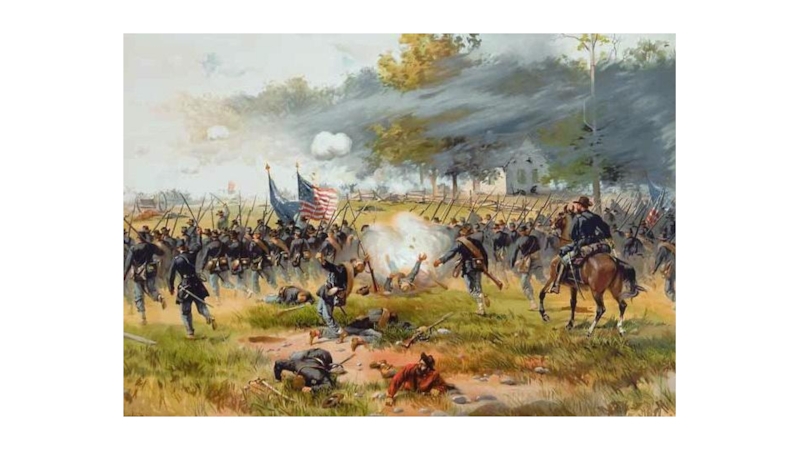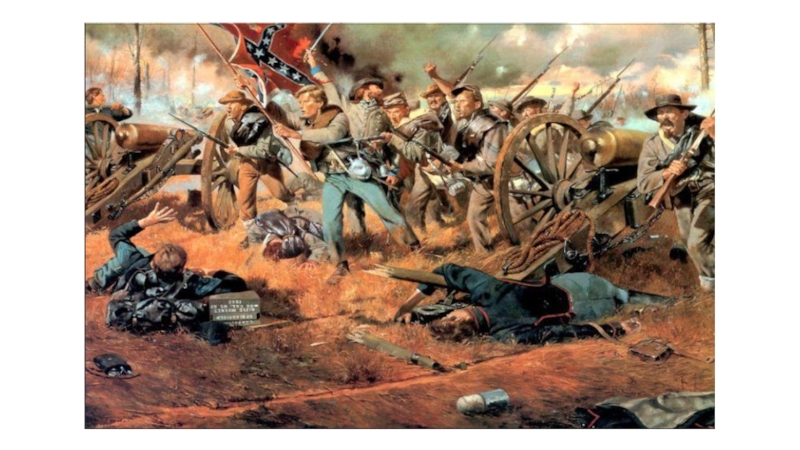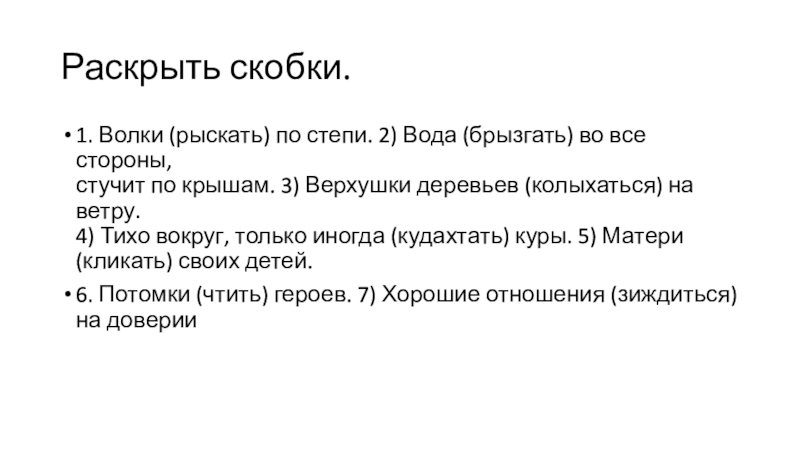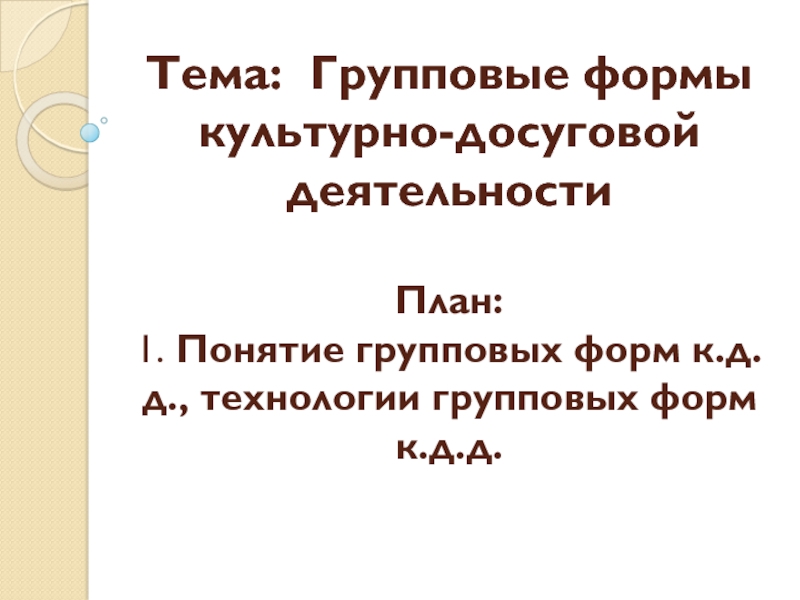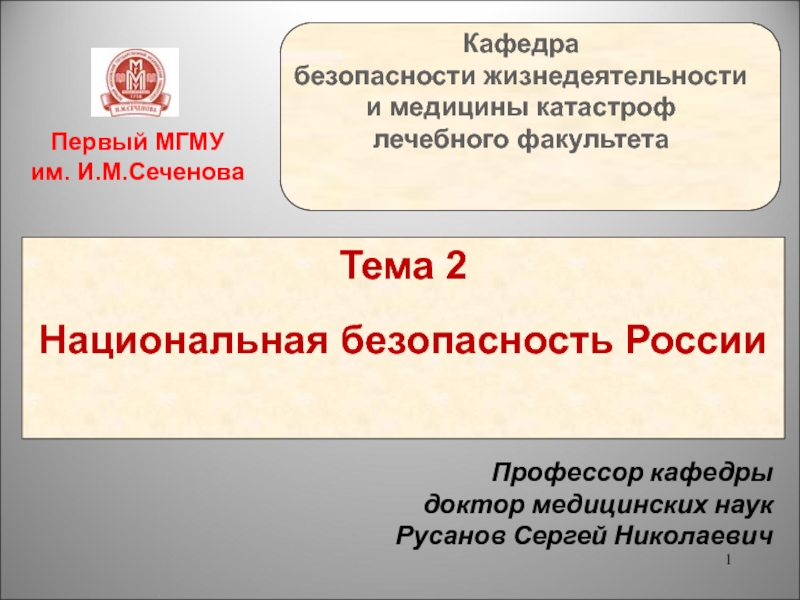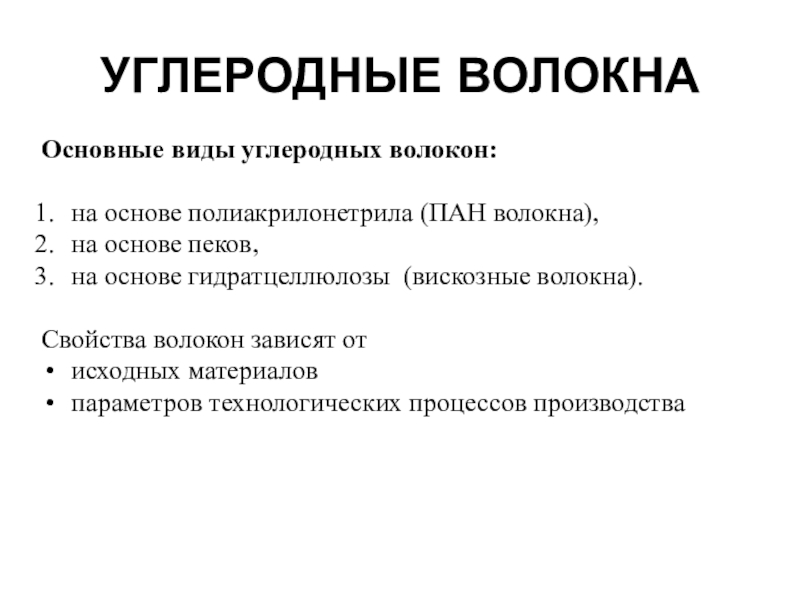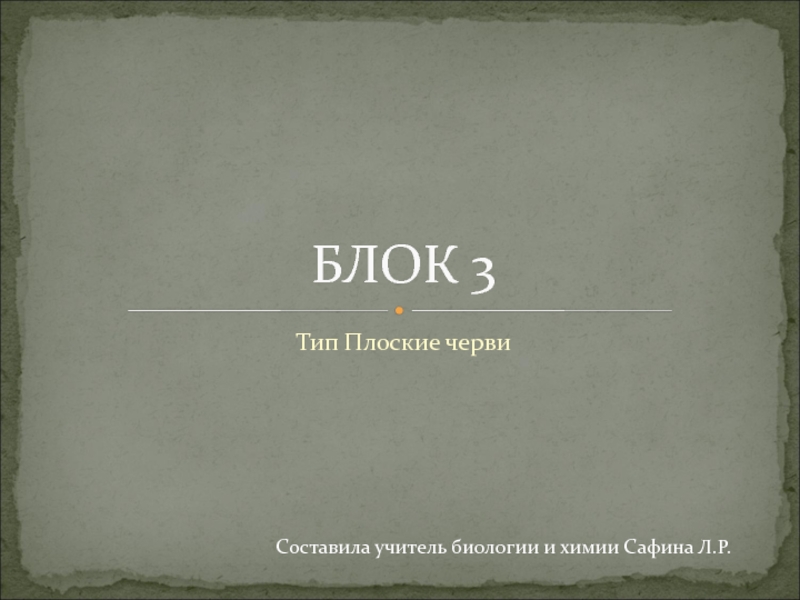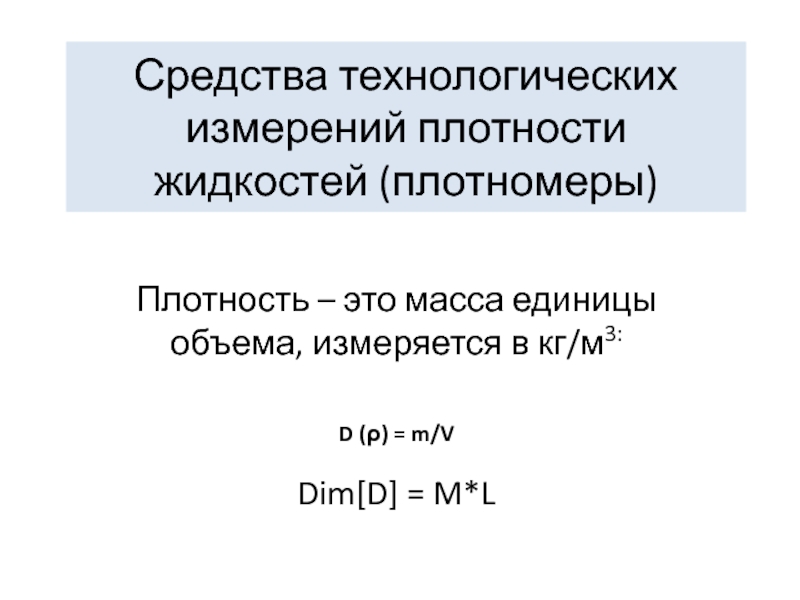Слайд 2Battle
Deployment of forces
September 15 General Lee has placed all its
available forces at Sharpsburg (Eng.) Russian., On the gentle hills
near the river entity Creek. It was a comfortable position, but it
was hardly impregnable. The river was a minor obstacle: it was 18-30 meters in width, and through it were several fords and stone bridges.
The danger was in the fact that behind the Confederate Army was the Potomac River with a single crossing (Botelers-Ford). September 15 at the disposal of General Lee was
a total of 18 000 people, a third of all the Confederate army.
The first two federal divisions appeared at noon on September 15 and the rest of the army - in the evening. Longstreet recalled:
Their number is still increasing, blue sea grew more and more, until it took the entire space, which could cover only look, and a huge army of McClellan
captivated the valley from mountain peaks to the shores of the creek. The sight of these mighty forces of inspire awe.
If the feds attacked the morning of the 16th, they would have had an overwhelming numerical advantage, but the legendary cautious McClellan - who decided that Lee's army 100,000
people - has led to the fact that the attack was postponed for a day. This enabled the southerners better to strengthen its position. In addition, the housing Longstreet had come out of Hagerstown,
Jackson and the body (excluding division Hill) - come from Harpers Ferry. Jackson is now defending the left flank, which rested on the Potomac, and Longstreet - right, south, which
rested in the entity. The entire defensive line stretches for 6 kilometers.
On the field at Danker Church was posted harried battles hungry Confederate division Hood. An hour before sunset on September 16 housing Feds Hooker crossed the river and entered the entity
exchanged fire with teams Hood, which lasted till night. After the battle, Hood asked Jackson to send the replacement of his division and give it at least a night out to make himself
food. Jackson immediately dispatched a team of Lawton, Trimble and Hayes. "He demanded, however, that I came back as soon as required," later recalled Hood.
The evening attack in some sense betrayed intentions McClellan. Lee realized that we should expect the attack was on the left flank, and threw back a portion of their forces. At the same time he
sent messengers to Harpers Ferry to the Hill and Maklouzu, announcing that they urgently need at Sharpsburg.
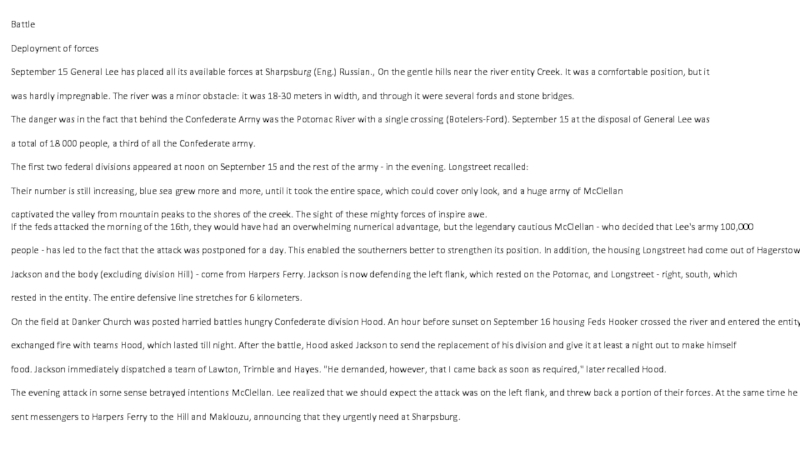
Слайд 5September 17. morning
Attack I Corps, 5:30 - 7:30 am
The battle
began at dawn, about 5:30, 17 September, I attack the
federal body of Joseph Hooker. Hooker moved to the plateau that housed "Dunker Church" (Eng. Dunker
Church), a building owned by the German Baptist church. Hooker had approximately 8,600 people, slightly more than that of Jackson (7700), but this slight advantage was reduced
for there is no strong defensive positions Southerners (Mal writes about 12,500 at Hooker and Jackson 4000).
Ebner Dabldeya Division advanced on the right flank, the division of James Rickett - on the left, and the Pennsylvania division of George Mead in the center and slightly to the rear. Jackson stood in
Defense Division Lawton and Jones. Four brigades Jackson kept in reserve [citation needed 308 days.
12-pound "Napoleon" was the most popular instrument of Antietam: 27 guns from the Army of the South, and 108 from the Army of the North
As soon as the first Union soldiers appeared in a cornfield, began an artillery duel. Confederate batteries fired from the west Jeb Stuart and four batteries
Colonel Stephen Lee Heights in the south Dunker Church. Feds meet with nine batteries for Northwood Ridge and four batteries of 20-pounder Parrott rifle with 3 positions
kilometers east of the entity Creek. Shootout caused substantial losses to both sides.
Noticing Confederate soldiers in a cornfield, Hooker ordered to pull artillery and cover the field grapeshot volleys. I Pennsylvanian team Mead (Brigadier General Truman
Seymour) began to move through the forest Eastwood and entered into a gunfight with a team alabamtsev, dzhordzhiantsev and severokarolintsev General James Walker. Once the team
Walker threw back the northerners, Division Rickett entered the cornfield, but was repulsed by artillery fire.
Federal brigade Abram Duriez came directly under the volley dzhordzhianskoy Brigade, Colonel Marcellus Douglass. Once under the impact fire from a distance of 230 meters and
received reinforcements, Durieux began to retreat.
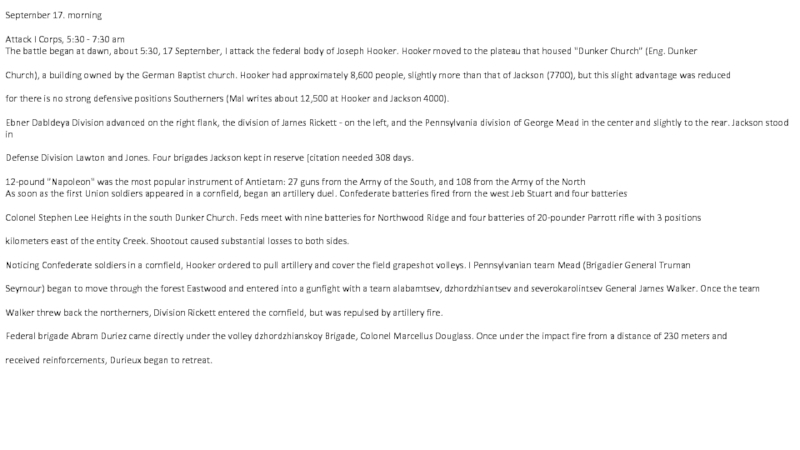
Слайд 6Expected Duriez reinforcements - a brigade Hartsuffa and Christian. They
did not manage to go to the battlefield, as Hartsuff
was wounded and left the field in general Christian
battlefield. When the teams were built and moved on the field, they came all the same intense artillery and rifle fire. Brigade "Louisiana Tigers" Harry T. Hays
threw them into the attack and knocked them to Eastwood. 12th Massachusetts Regiment suffered on that day the heaviest losses - 67% of its composition. The brigade also came under Hayes
artillery fire and retreated from the field. Of the 500 people on the team 323 perished.
Luiziantsy Brigade soldiers after the battle in Starke Dunker Church. Photo by Alexander Gardner, September 1862
Attack of the Iron Brigade at the Battle of Antietam
In the area of cornfield northerners offensive stalled, but a few hundred yards east of their business was more successful. 4th Brigade Gibbon ("Iron Brigade" of
Division Dabldeya) was able to drop soldiers Jackson. But they were stopped by soldiers of the brigade attack in 1150 Starke, who opened fire on them from a distance of 30 meters. intense
Iron fire brigade stopped the attack, moreover, was mortally wounded himself, General Stark. Feds resumed the offensive and managed to break through the defensive line of Jackson,
so the whole defense Southerners on this site could collapse at any moment. Despite heavy losses, the body Hooker confidently move forward.
However, about 7:00 Southerners were reinforced: the division Maklouza and Anderson came out of Harpers Ferry. Around 07:15 General Lee sent dzhordzhiantsev Anderson from the right
flank to help Jackson.
Meanwhile, Jackson was no longer any of its parts, but he thought of the Texas Division Hood and ordered them to attack the advancing units Hooker. Hood Brigade, participated in the
evening shootout and had not time to sleep and prepare your own meals. "... An officer from the headquarters of Lawton rushed to me and said:" General Lawton sends his congratulations and
asks you to come to support him. "Sounded: "To arms!" And my soldiers were again forced to go into battle, leaving the camp all the uncooked food. "
Texans entered the cornfield and opened fire on northerners who have considered themselves the victors. Brigade Gibbon, Phelps and Hoffman were disorganized and instantly
began to retreat. However, the Texans had too little (2000), and they also lost the organization. Especially hard had 1st Texas regiment, which has come under fire
Pennsylvanians and retreated, losing banner. 226 soldiers from the regiment were killed 186. Losses in other regiments Hood were also high: 5th Texas Regiment lost 86 out of 175, 4th
Texas - 100 of 200. Subsequently, General Lee Hood said: "My division was almost wiped off the face of the earth."
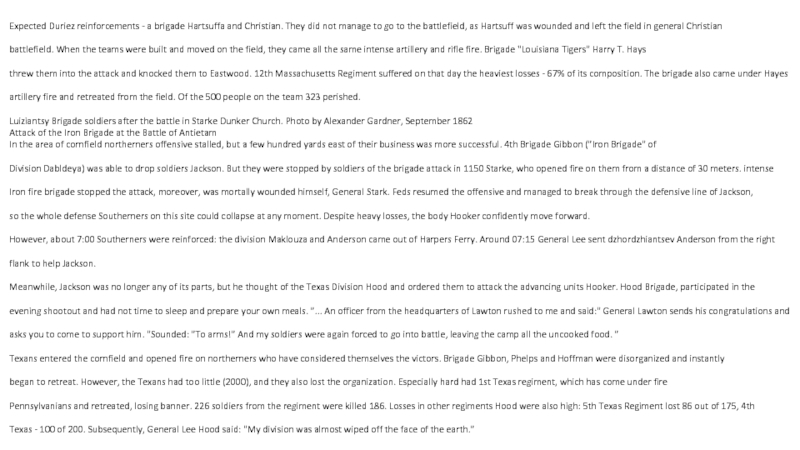
Слайд 8Division Hood died halfway, but she stopped and forced to
retreat Dabldeya Rickett and Mead. As a result, at 7
am 12,000th body northerners was defeated and lost
combat capability. Corps lost 2,470 killed and wounded, including General Hooker. In the body there are about 7,000 people.
Then Hooker sent an offensive Mansfield XII Corps, which numbered 7,200 people. Mansfield himself was almost immediately killed by a stray bullet and took command of Alpheus
Williams. Hooker gave him orders just before he was wounded.
XII Corps launched an attack. Green Division entered the Eastwood briefly detained, the soldiers met resistance Lawton and Daniel Hill, but the federal artillery helped
Greene break the resistance of the Confederates. By this time, the division Lawton practically ceased to exist, were injured, many generals and colonels himself Lawton. he passed
command of the division Dzhubalu Earley, who temporarily handed over his brigade William Smith. Federal XII Corps went Eastwood and went to the cornfield. Here he met
remnants of the division Hood, who began to retreat, firing. Green went on a plateau at Danker Church. Simultaneously published in the cornfield federal division Sedgwick (5400
people; following with her French's division lost on the way).
Green was very close to capture Dunker Church, but at this point it attacked last reserve the Confederate left flank - Brigade Jubal Early. In Earley was little chance of
success, but he was able to stop the Feds. At that time, about 7:30, came Maklouza division. Reinforced while moving another brigade, the division had 6,500
people. It was the last reserve of General Lee.
Maklouz deployed troops to the battle line and attacked the federal division of Green. Inexperienced soldiers XII Corps fled. Continuing the offensive, attacking Maklouz
the right flank of the division Sedgwick. First ran Philadelphia Brigade Howard, then the rest of the brigade. McClellan later describe it as follows: "Going into the woods
west of the road and throwing the enemy front line came under musket fire from the enemy fortifications and batteries on the hill. At the same time a large column of the enemy was able to
Green push the division and went to the rear and flank division Sedgwick. "On this occasion, Earley later remarked that earthworks during the battle was not built only on their
next day, fearing a repetition of attacks.
Northerners are no longer tried to attack the Confederate left flank, and the battle ended on this site.
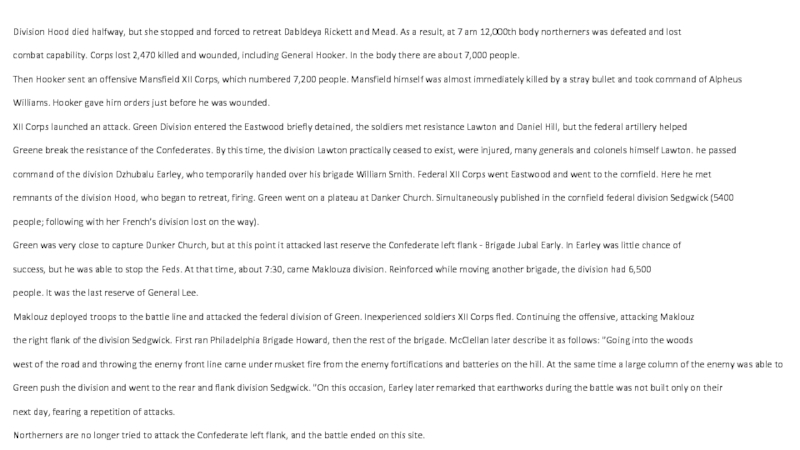
Слайд 9September 17. day
Attacks XII and II Corps, 9:00 - 13:00
At
noon, the main burden fell on the center line of
the Confederacy. Sumner supported housing division Sedgwick morning attack, but French's division lost and somehow
headed south, and now French wanted to quickly join the battle. In front of him was the weakest portion of the Confederate defense, only 2,500 people (team and Colquitt
Rhodes), less than half of French's division, but their positions were strong. Their right flank stood along the "road flooded" Sunken Road (Eng. Sunken road), which was a
something like a natural trench [i 4].
At 9:30 began classical French bayonet charge in the spirit of the Napoleonic Wars: three of his team built a tower, reached the line and turned in three consecutive lines.
Weber was the first team, then neobstrelyannyh team Morella, for her - a team Kimball. With uncharged muskets and fixed bayonets, a marching band music, they
went on the attack.
Banners waving over them, not yet faded from the dust and smoke of battle - wrote Colonel Gordon - Bayonets glittered in the sun like silver Cleaned, a clear step by holding
alignment, both on the parade, this magnificent structure was moving up to the attack by uterine roar of drums ...
Impact was mainly on brigade Rhodes. Colonel John Gordon guessed that the enemy comes with uncharged guns and ordered his men to let the enemies as possible
close "to each bullet has done its job." After letting the enemy so close that eagles were visible on the buttons, Gordon ordered "Fire!". The effect of this salvo "was ...
terrifying. The entire front line, with rare exceptions, was smetena.I before the rear line recovered from the shock, my people enthusiastically jumped to his feet and opened
fire on the enemy. "Morella brigade immediately departed, keeping order. Northerners were huge losses, while the regiment Gordon did not get a single scratch. brigade
Kimball and Weber retreated to the starting line, regrouped and went on the attack again. Total French undertook 4 attacks, and only then ordered to charge the rifle and
open fire. All during these attacks French lost 1,750 of its 5,700.
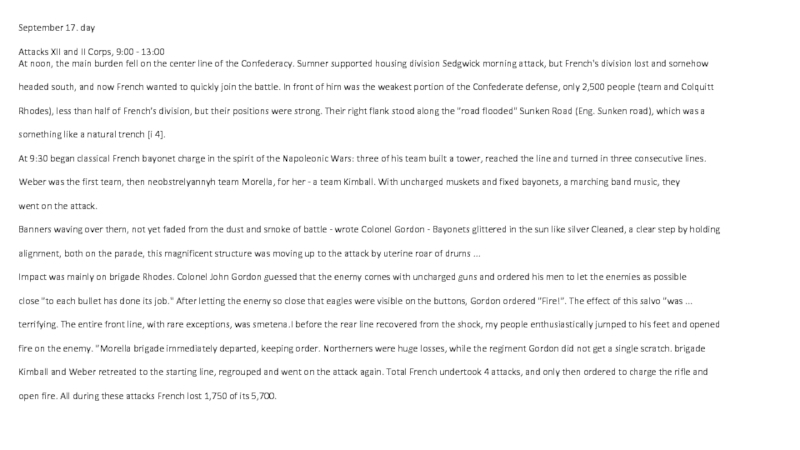
Слайд 10Both sides received reinforcements, and at 10:30 Robert E. Lee
sent to the aid of Daniel Hill his last reserve
- Division Richard Anderson, around 3,400 people. She had to
strengthen the line Hill, extend it to the right and to prepare for the attack on the left flank of the French's. However, at this time on the left appeared a French division of Israel Richardson
about 4,000 people. This was the last of the three divisions of Sumner, which previously stood in the rear as a reserve.
Irish Brigade led the attack Thomas Meagher. They marched under the banner of emerald green, and the regimental chaplain William Corby traveled down the line, promising going on
Death absolution. Brigade stood under enemy fire for 40 minutes, 570 people lost and retreated. Richardson then sent forward a brigade of John Caldwell, and this
time attack went well. General Richard Anderson was injured at the beginning of the fight, left the battle and other officers: George Anderson was injured and John Gordon. Rhodes was
wounded in the thigh, but did not leave the battlefield. Left with little or no commanders Division Anderson began to move away. Brigade Caldwell walked right wing confederate lines.
Colonel Francis Barlow, advancing at the head of 350 people from 61 th and 64 th New York regiments, noticed a weak point in the defense of the enemy and captured the site Sunken Road, opening
enfilade fire on the enemy trenches.
We shot them out like sheep in the pen, - later recalled soldiers northerner - if the first bullet flies past, it could ricochet from the wall of the ravine, and then still hit.
Southerners, who died at the Sunken Road
To save flank, Rhodes ordered James Lightfoot (successor General Gordon) curved line of defense, but Lightfoot misunderstood orders, and part of it began to recede, which
led to the retreat and rest Brigade regiments. Line of defense collapsed, Southerners began to retreat to Sharpsburg.
People Richardson began to pursue the retreating enemy, but came under massive artillery bombardment, hastily organized Longstreet. "Fortunately for Southerners
Longstreet was at the right time and right place. He ordered his staff officers dismount and become the guns. While the general himself kept his aides horses and orderlies,
those charged gun and fired at the enemy, literally without giving him an opportunity to lean out of the crest of the hill. "Fire were only two guns, but they forced the feds move.
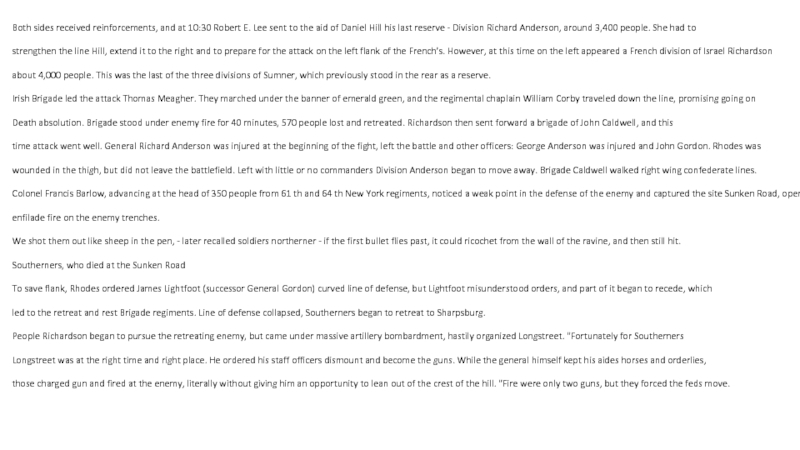
Слайд 11Daniel Hill personally led 200 men in a counterattack on
the left flank of the enemy near the Sunken Road,
but was repulsed a counter-attack of the 5th New Hampshire Regiment. now defense
center no longer existed, and the division of Richardson had before him an open field. No one could stop the offensive of the federal army, but there was no one to attack. division
Richardson has lost about 1,000 people and continue the attack could not. Colonel Barlow was wounded, and most importantly, himself Richardson was injured and was sent to the rear.
Took command Winfield Hancock, who was a very capable divisional commander, but because of the change of command right moment was missed.
Fight for the 700-meter stretch of the Sunken Road lasted from 9:30 to 13:00 and claimed the lives of 5,600 people: 3,000 northerners and southerners in 2600 (according toK. Malyu - 1500 [24]).
For northerners began this fight huge missed opportunity. If they used their success in the center of the army Lee would be cut in half and destroyed by chastyam.Neobhodimye forces for this
were: reserve in 3500 cavalry and 10,300 infantry from V Corps under General Porter was very close, VI Corps (12,000people) was on its way. Major General William Franklin was even willing to
intervene, but Sumner ordered him not to show initiative. Franklin addressed directly to the Makklelanu, who personally came to understand the situation, but, for unclear reasons, commander
in chief took the side of Sumner. Later that same day, Gen. George Sykes (commander of the 2nd Division V Corps) proposed Makklelanu repeat the attack center, to which Major General Fitz
John Porter (commander of the 5th housing), according to him, said Makklelanu: "Remember, General, I command the last reserve of the last Army of the Republic." This statement caused
McClellan thought, and another chance was missed.
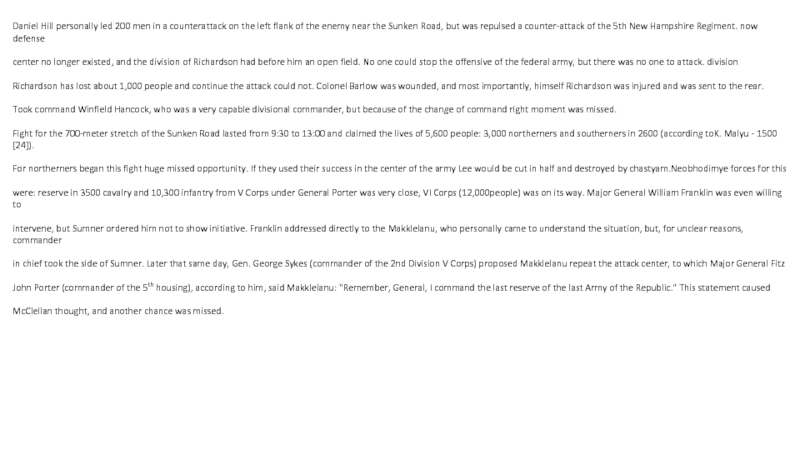
Слайд 12September 17. evening
Offensive IX Corps, 10:00 - 16:30
Now the main
events took place on the south side of the battlefield.
Plan B. McClellan meant offensive IX Corps under General Burnside to divert Confederate and
support housing Hooker. However, Burnside was told to wait for the order, and the order did not come until 10:00. Burnside idle all this time.
At Burnside was 4 divisions - 12,000 people and 50 guns (Mal mentions 13,500 people). Opposing him strength were seriously weakened when Lee threw some of them
on the left flank. At dawn there were divisions Jones and Walker, but by 10:00 the division was withdrawn Walker and Anderson's brigade. Now Jones had only 3,000 people and 12 guns,
that and had to resist the body Burnside. The four teams held a hill near Sharpsburg, mainly flat plateau known as Cemetery Hill.
The remaining 400 (2nd and 20th regiments dzhordzhianskie Robert Toombs) with two artillery batteries defended Rorbahsky bridge trёhprolёtny 38-meter-long stone bridge,
which went down in history as a bridge Burnside. The bridge was a serious obstacle. Leading to it was a road along the river and is well exposed to fire. On the west is the 30-meter
hill, strewn with boulders from an old quarry, which was the perfect hiding place for infantry and artillery defending the bridge.
Realizing that take the bridge frontal attack will not be easy, Burnside sent a division Rodman bypass to strike the right Toombs County. In order not to lose time, Burnside decided all
same attack on the forehead. First team went into battle Kruk, but quickly retreated with heavy losses. Then went into battle brigade of the division Nagle Sturgis, but their attack
choked.
Never before has the power of defense armed infantry rifles has not been demonstrated so vividly and convincingly: 400 people who have taken a good position, for three hours
held the line against the 13,000th body, and he was completely powerless to do anything about it.
When the division Rodman finally got into position to attack, began the third attempt to seize the bridge. From the front, advancing the 9th, 51th New York and 51th Pennsylvania regiments. K
this time dzhordzhiantsy Toombs County had already shot all the bullets. Came under attack from the front and flank, they retreated. Now housing Burnside went straight to the weakening of
the right
flank the Confederate army and Lee was threatened - to reflect the federal attack was nothing.
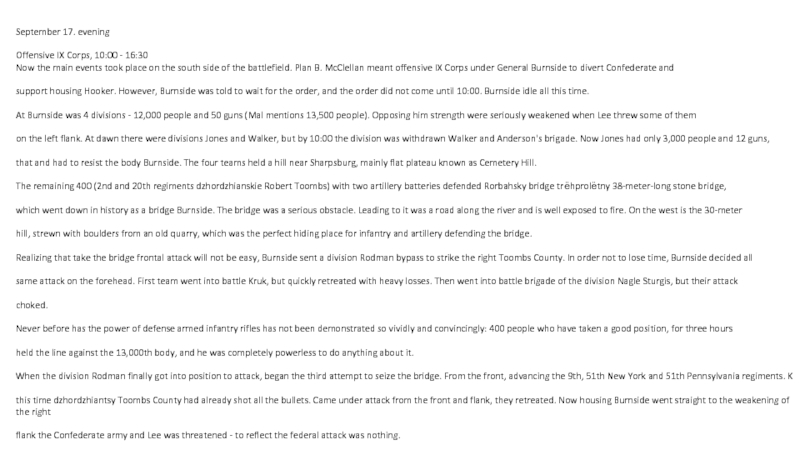
Слайд 13However, the onset of IX Corps halted. Division Sturgis shot
almost all of the charges, and it was decided to
replace her division Wilcox. Only three in the afternoon was
formed a battle line: Right Division Wilcox (team Christa, Welsh and Crook), left the brigade Harland, Fairchild and Skemmona. 8,000 people, with 22 guns. these two
fresh divisions opposed exhausted and weakened Division David Jones: in fact, only teams Kemper and Drayton. When northerners began to advance, they immediately start
depart. At 15:30 division Wilcox entered the outskirts of Sharpsburg.
Wu Li was no more reserves, but at this very moment in the south there was a division in blue uniform, which was first adopted for federal, but turned out to be a division Ambrose
Hill, who came back at 15:30 from the Harpers Ferry. Hill immediately (at 15:40), launched in the division line and attacked the left flank of the IX Corps - South Carolina brigade Maxi
Gregg struck on the 16th Connecticut Regiment Rodman division commander was killed almost immediately. First took flight crew Harland, and behind it and the gang
Skemmona. IX Corps lost about 20% of its composition, but still twice the size of the enemy numerically. But federal crews began to retreat to the bridge. They still had
opportunity to repeat the attack, and Burnside asked the McClellan reinforcements, but he decided not to risk it, even though he was in the reserve corps Porter and Franklin. At 17:00 the battle
Was completed.
When the fight was already calmed down and Confederate generals gathered for the meeting, federal bullet sniper was killed on the spot, Brigadier General Lawrence O'Brien Branch of the
Division E. Hill.
